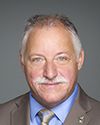Again, General Jon Vance has spoken about this, universality of service. I know they've set up a tiger team and they're looking at it, which for me is very encouraging because this conversation would not have taken place as little as three to five years ago.
I think the Canadian Armed Forces under General Jon Vance had determined that there is value in these members. Yes, they might be ill or injured and might not be able to do everything, but they can bring value back to the organization. There's talk around looking at easing of universality of service, and I think that's a good thing. I think the assets we can hang onto are going to be tremendous.
Secondarily, easing of the universality of service may allow those—and we always talk about the stigma that's attached to operational stress injuries and mental health. There may be an opportunity where we could open that door a little further where people wouldn't feel so stigmatized or that this is the end of their career if they come forward.
I think there is great possibility in that. I think this is a modernization piece. I'm very pleased to see that the conversation has started.




